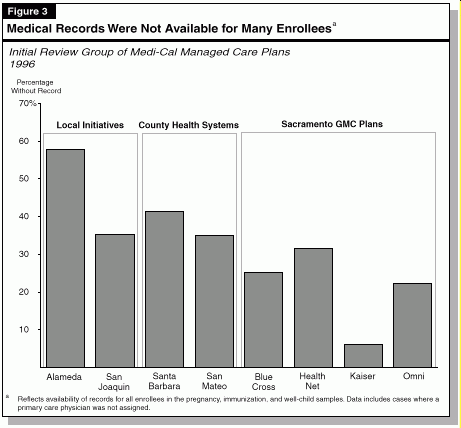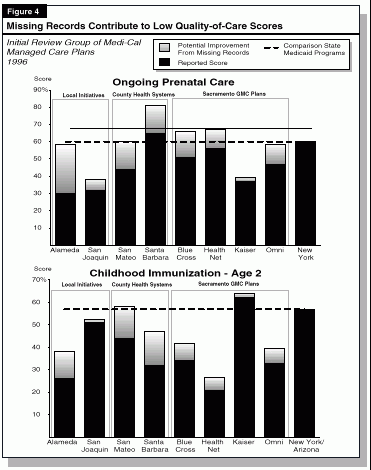

The Department of Health Services (DHS) recently released the first set of independent quality reviews of Medi-Cal managed care plans. These reviews examined the performance of eight plans during 1996 as measured by nine quality indicators for prenatal care and ten quality indicators for pediatric preventive care--a total of 19 indicators. Prenatal and pediatric preventive "well-child" care are particularly important for Medi-Cal managed care plans because most of the enrollees in these plans are families with children. The plans that were reviewed currently enroll 14 percent of the Medi-Cal beneficiaries who are in managed care.
Overall, the results of these initial reviews were disappointing and indicate that there is much room for improvement.
Currently, about 2.2 million Medi-Cal beneficiaries are enrolled in managed care plans--about 45 percent of total Medi-Cal enrollment. In most of the state's more populous counties, families in Medi-Cal generally are required to enroll in a managed care plan.
The federal government requires the state to contract with an independent external quality review organization (EQRO) to measure plan performance, identify areas that need improvement, and measure progress over time. The DHS contracted with the Health Services Advisory Group, Inc. to perform these evaluations using the latest Health Plan Employers Data and Information Set (HEDIS) methodology, which is nationally accepted. Of the 19 indicators, nine are HEDIS care standards and ten are additional Medi-Cal guidelines adopted by DHS.
The eight plans in this initial review are listed in Figure 1 (see page 2). They include plans operating under all three of the "models" of Medi-Cal managed care that exist in various counties throughout the state (see insert box). According to DHS, reviews of the remaining 14 plans that provide Medi-Cal managed care will be completed by January 1999.
| Figure 1 | |
| Medi-Cal Managed Care Plans
Evaluated in Initial Quality Review | |
| Plan | Medi-Cal Enrollment (June 1998) |
| Local Initiative Plans in Two-Plan Counties | |
| Alameda Alliance for Health | 72,447 |
| Health Plan of San Joaquin | 57,129 |
| County Organized Health Systems | |
| Health Plan of San Mateo | 42,865 |
| Santa Barbara Regional Health Authority | 37,216 |
| Geographic Managed Care Plans--Sacramento County | |
| Blue Cross of California Medi-Cal Programs | 43,517 |
| Health Net (formerly Foundation) | 24,350 |
| Kaiser Foundation | 18,842 |
| Omni Healthcare | 26,626 |
Medi-Cal Managed Care Models |
|
The review produced a total of 151 separate evaluations (19 quality-of-care indicators for each of eight plans, with one case of insufficient data). The great majority of the results (129 of these evaluations, or 85 percent) indicate that fewer than half of the Medi-Cal enrollees received adequate care (as documented in their medical records), based on the criteria established for each type of care that was evaluated. Moreover, results for more than one-fifth of the evaluations indicated that less than 10 percent of Medi-Cal enrollees received documented adequate care. Scores for most of the plans also generally fell below the scores of plans in the New York and Arizona Medicaid managed care programs, which the EQRO presented for comparison purposes.
Figure 2 summarizes the results of the quality reviews by showing the average score of each plan when the indicators are grouped into three categories: prenatal and postpartum care (nine indicators), immunization of two-year-old children (one indicator), and well-child care (nine indicators). The scores represent the percentage of the sample of enrollees who received adequate care, as documented in their medical records. Figure 2 shows that only three of the average scores exceeded 50 percent, and a third of the scores were under 25 percent. The only plan to score over 50 percent in at least two of the three categories was the Sacramento Kaiser plan. We also note that the type of Medi-Cal managed care model appears to make little difference in the average scores.
| Figure 2 | |||
| Initial Group of Medi-Cal Managed Care Evaluations
Average Quality Indicator Scores 1996 | |||
| Enrollees Receiving Adequate Care | |||
| Prenatal and
Postpartum Care |
Immunization
of Two-Year Olds |
Well-Child
Care | |
| Local Initiative Plans | |||
| Alameda Alliance for Health | 21.3% | 26.0% | 16.3% |
| Health Plan of San Joaquin | 23.4 | 51.0 | 17.7 |
| County Organized Health Systems | |||
| Health Plan of San Mateo | 29.1% | 44.0% | 25.8% |
| Santa Barbara Regional Health Authority | 34.3 | 32.0 | 15.0 |
| Sacramento Geographic Managed Care | |||
| Blue Cross | 34.4% | 34.0% | 23.2% |
| Health Net | 33.4 | 21.0 | 27.8 |
| Kaiser | 50.9 | 62.0 | 25.4 |
| Omni | 31.0 | 33.0 | 24.6 |
The HEDIS methodology treats missing records the same as a lack of care, based on the rationale that managed care
requires good record keeping, and excluding missing records when measuring performance would give plans
an incentive to withhold records of poor-quality providers from the EQRO contractor. One reason for the low scores in the
EQRO study was that medical records could not be found for a significant portion of most plans' enrollees. Figure 3 (see
page 4) shows that, for most plans, medical records were unavailable for between 20 percent and 40 percent of the
combined samples of enrolled women and children.

According to DHS, a lack of follow-up by some plans may have contributed to the large numbers of missing records. In many cases, doctors, clinics, and other providers did not supply the EQRO with requested medical records for enrollees in the samples on a timely basis. Department staff indicate that health plans need to make requirements for supplying records clear to their providers and do a better job of assisting the EQRO to obtain records from them.
The scores reflect combined performance in providing care and documenting the care. Consequently, the scores generally understate the actual percentages of enrollees who received adequate care. For example, records could not be located for 48 percent of the sample of pregnant women for the Alameda Alliance for Health. Therefore, that plan could not score above 52 percent on the prenatal and postpartum care indicators. Thus, low scores can reflect a mix of a lack of care and poor record keeping.
Estimating the Potential Impact of Missing Records. In order to get some indication of the extent to which missing records, rather than a lack of care, could be the main reason for low scores, we developed a measure of the potential scoring "penalty" due to missing records. This measure calculates the improvement in scores that would have occurred if (1) all of the missing medical records (as reported by the EQRO) had been located and (2) those records showed that care was provided to the same degree as the records that were examined.
Figure 4 illustrates the results of this calculation for two indicators the frequency of ongoing prenatal care and childhood
immunization at age 2.

As Figure 4 shows, missing records could be a major cause of the plans' low scores. For the prenatal care indicator, better record keeping might have raised six of the eight plans' scores to near or above the comparison score shown for the New York Medicaid Managed Care Program (if enrollees with missing records received care as frequently as other enrollees). We note, however, that we could not make a comparable adjustment for missing records for New York because data were not available. For the childhood immunization indicator, Figure 4 shows that better record keeping might have significantly increased most of the plans' scores. Nevertheless, most scores would have remained significantly below the Arizona and New York Medicaid immunization levels even if they had not had missing records.
For both indicators, Figure 4 demonstrates that the relative ranking of many of the plans may reflect the ability of plan providers to locate medical records as much as it does the actual provision of care. Figure 4 also illustrates another finding of the EQRO study: the plans performed inconsistentlythose that scored well for one type of indicator often scored poorly on another.
In their initial comments to DHS, the health plans cited a number of problems with the EQRO evaluation. For example, public health immunization clinics generally do not forward immunization records to a child's primary care provider, and providers may not have documented the care that they gave. The plans also argue that there was confusion about evaluation procedures and that there was only a short time to respond to requests for medical records. In addition, the two local initiative plans (Alameda and San Joaquin) were in their first year of operation and may have encountered start-up problems.
The initial set of Medi-Cal managed care quality reviews shows that:
In its comments on the reviews, DHS points out that there are no previous Medi-Cal quality-of-care data (either for managed care or for traditional fee-for-service care) with which to compare the current findings. Consequently, there is no way of knowing whether plan performance has improved or deteriorated over time or whether Medi-Cal managed care plans are providing better or worse care than was provided under fee-for-service Medi-Cal. Instead, the initial round of evaluations will serve as a benchmark for identifying and measuring needed future improvements in care and record keeping. The department plans to meet with the health plans in September and ask them to prepare corrective action plans to improve performance. Recognizing current record keeping problems, the department also intends to implement a 2 percent performance incentive payment next year for better reporting of patient data by Medi-Cal managed care plans. The department and Blue Cross also will be testing means of improving medical record reporting through better communications and feedback between the EQRO and health plans.
July was the initial month of operation for the state's new Healthy Families Program, which offers health coverage for children in families with incomes under 200 percent of the federal poverty level, but above Medi-Cal limits. The Managed Risk Medical Insurance Board, which administers the program, began taking applications in June for enrollment starting July 1. The administration had estimated that 25,000 children would be enrolled in the program for July, and that 16,000 additional children would enroll each subsequent month during 1998-99. However, actual enrollment as of August 3 was only 4,765, indicating that initial enrollment is substantially below the administration's expectations.
Contact--Dan Rabovsky--(916) 445-6061
| California Update is published monthly--except January and February--by the Legislative Analyst's Office (LAO). The LAO is a nonpartisan office which provides fiscal and policy information and advice to the legislature. The LAO is located at 925 L Street, Suite 1000, Sacramento, CA 95814.To request publications call (916) 445-2375. Reports are also available on the LAO's World Wide Web page at http://www.lao.ca.gov. |